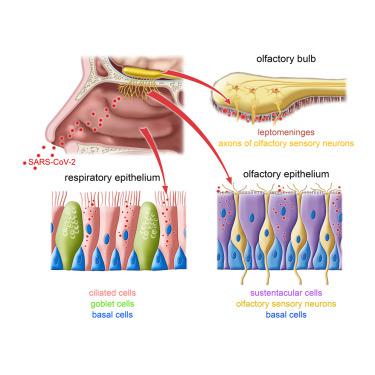Cell ( IF 45.5 ) Pub Date : 2021-11-03 , DOI: 10.1016/j.cell.2021.10.027 Mona Khan 1 , Seung-Jun Yoo 1 , Marnick Clijsters 2 , Wout Backaert 3 , Arno Vanstapel 4 , Kato Speleman 5 , Charlotte Lietaer 5 , Sumin Choi 1 , Tyler D Hether 6 , Lukas Marcelis 4 , Andrew Nam 6 , Liuliu Pan 6 , Jason W Reeves 6 , Pauline Van Bulck 7 , Hai Zhou 1 , Marc Bourgeois 8 , Yves Debaveye 9 , Paul De Munter 10 , Jan Gunst 9 , Mark Jorissen 11 , Katrien Lagrou 12 , Natalie Lorent 13 , Arne Neyrinck 14 , Marijke Peetermans 10 , Dietmar Rudolf Thal 15 , Christophe Vandenbriele 16 , Joost Wauters 10 , Peter Mombaerts 1 , Laura Van Gerven 17

|
Anosmia, the loss of smell, is a common and often the sole symptom of COVID-19. The onset of the sequence of pathobiological events leading to olfactory dysfunction remains obscure. Here, we have developed a postmortem bedside surgical procedure to harvest endoscopically samples of respiratory and olfactory mucosae and whole olfactory bulbs. Our cohort of 85 cases included COVID-19 patients who died a few days after infection with SARS-CoV-2, enabling us to catch the virus while it was still replicating. We found that sustentacular cells are the major target cell type in the olfactory mucosa. We failed to find evidence for infection of olfactory sensory neurons, and the parenchyma of the olfactory bulb is spared as well. Thus, SARS-CoV-2 does not appear to be a neurotropic virus. We postulate that transient insufficient support from sustentacular cells triggers transient olfactory dysfunction in COVID-19. Olfactory sensory neurons would become affected without getting infected.
中文翻译:

在已故的 COVID-19 患者中观察 SARS-CoV-2 如何攻击呼吸道和嗅觉粘膜但保留嗅球
嗅觉丧失(嗅觉丧失)是 COVID-19 的常见且通常是唯一的症状。导致嗅觉功能障碍的一系列病理生物学事件的发生仍然不清楚。在这里,我们开发了一种尸检床边手术程序,以通过内窥镜采集呼吸道和嗅觉粘膜以及整个嗅球的样本。我们的 85 例病例队列包括感染 SARS-CoV-2 几天后死亡的 COVID-19 患者,这使我们能够在病毒仍在复制的同时感染病毒。我们发现支持细胞是嗅粘膜中的主要靶细胞类型。我们未能找到嗅觉感觉神经元感染的证据,嗅球的实质也幸免于难。因此,SARS-CoV-2 似乎不是嗜神经病毒。我们假设来自支持细胞的短暂支持不足会触发 COVID-19 中的短暂嗅觉功能障碍。嗅觉感觉神经元会受到影响而不会被感染。











































 京公网安备 11010802027423号
京公网安备 11010802027423号